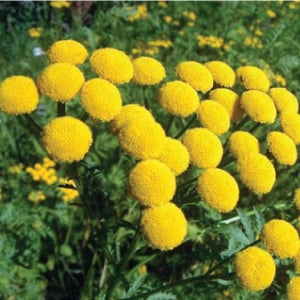
Learning Download: How to Grow Tansy
From Seed to Harvest: A beginner’s guide to growing tansy
Tansy is an herb with yellow blooms that is often used to repel insects, ants and mice from the garden. Tansy is a perennial that originated in Europe and was used medicinally in the past. In addition to repelling pests, tansy can replenish the soil with potassium. Tansy is even sometimes considered an invasive weeds, as it easily reseeds itself and spreads quickly. Tansy is a member of the daisy family and can reach up to 4 feet in height . It has fern-like leaves. Tansy can be used to flavor stews and more, but only a small amount should be used at a time.
To plant:
If planting in the spring, sow directly into the garden 1/4-inch-deep as soon as the danger of frost has passed. Cold stratification means to break a seed’s dormancy to allow the seed will germinate in 15 to 30 days. Tansy seeds can be started indoors as early as eight weeks before the last frost if being planted in the spring. Tansy plants also can be planted in the fall, but this is usually done by dividing established tansy plants and planting the divisions not growing them from seeds.
To grow:
Once tansy plants are seedling size, thin them to 6 inches apart. Tansy can grow in full sun or partial shade. It does best in fertile, well-drained sol and in an area that has little vegetation already established. Tansy is often used as a companion plant in the garden as it repels many pests, and it has even been used in the past to kill parasites internally in humans and animals. Tansy flowers are long-lasting. Tansy grows well as a border or edging. Once they are established, tansy plants require little attention.
To harvest:
The leaves and the flowers of the tansy plant can be harvested. Tansy can be added in light doses to culinary dishes, but its best use is as an insect repellant. Tansy naturally repels pests in its plant state, but the plant also can be harvested and made into a liquid that is then sprayed around the garden. To do so, harvest both the leaves and flowers during the plant’s flowering period, which is from June to September. Add dehydrated tansy into steaming water and spray around the garden. Harvest a bunch of tansy leaves and hang indoors to serve as a fly repellant. The leaves and flowers of tansy also can be used to create colored dyes.
What tansy craves:
Although tansy plants can thrive in poor soil, it is best to amend the soil with plenty of compost prior to planting the tansy seeds. Add fertilizer once a month to the plants.
Where to buy tansy seeds:
You can find tansy seeds at Urban Farmer.

